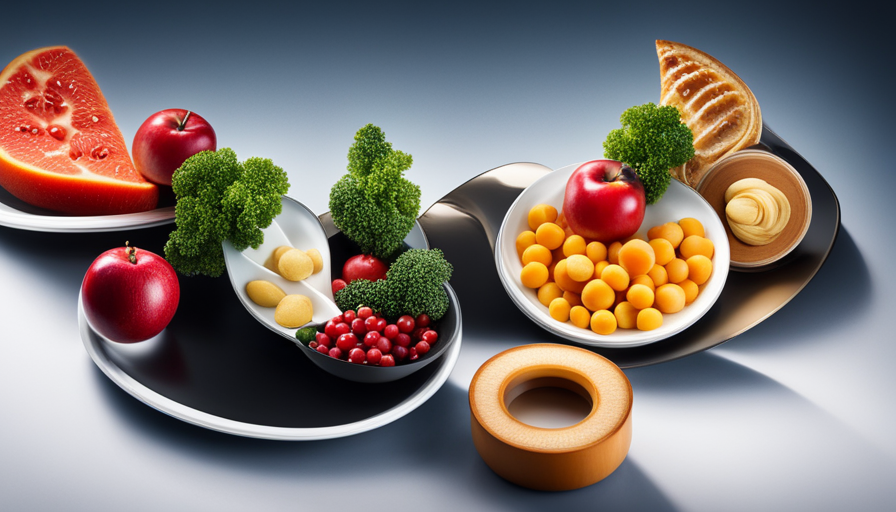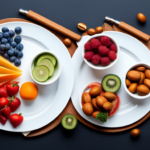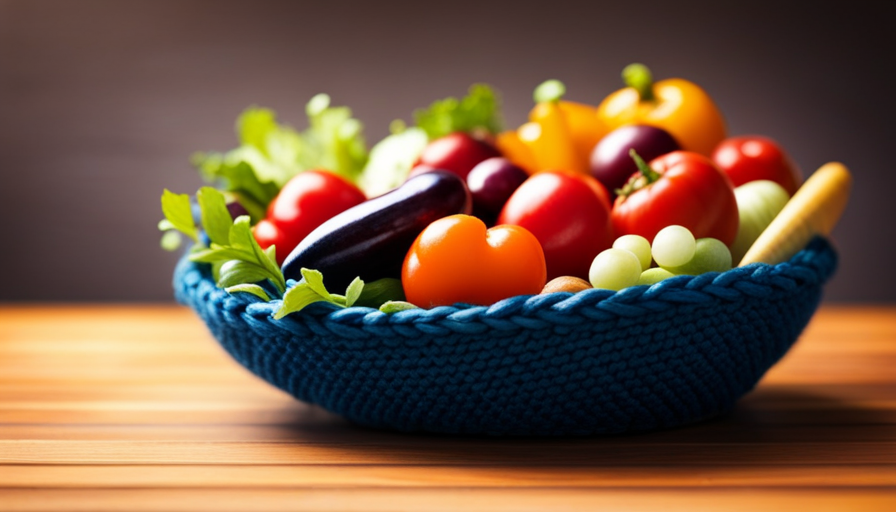Picture your body like a high-performing machine, running on top-notch, pure fuel. Just as a sports car functions optimally with premium gas, our bodies excel when fueled with top-quality nutrition.
That’s where the raw food diet comes in. Like a refreshing breeze on a hot summer day, this diet offers a fresh approach to weight loss and overall health. In just three weeks, you can shed those extra pounds and feel rejuvenated, all while enjoying delicious, nutrient-dense meals.
But it’s not just about what you eat, it’s also about when you eat. By carefully timing your meals and controlling your calorie intake, you can maximize your weight loss results.
In this article, I will guide you through the ins and outs of the raw food diet, providing you with a meal plan, tips for portion control, and strategies for long-term maintenance. Get ready to revitalize your body and transform your life with the raw food diet.
Key Takeaways
- Timing meals can optimize metabolism and manage calorie intake.
- Consuming more calories earlier in the day may have a positive impact on weight loss.
- Portion control is important in the raw food diet for weight loss.
- Regular exercise, like brisk walking or cycling, can burn calories on the raw food diet.
Understanding the Raw Food Diet
Looking to shed some pounds and embrace a healthier lifestyle? Dive into the world of the raw food diet and discover the secret to effortless weight loss!
The raw food diet is a way of eating that focuses on consuming uncooked, unprocessed, and mostly plant-based foods. By following this diet, you can not only lose weight but also improve your overall health and well-being.
One of the main benefits of the raw food diet is that it encourages meal prep. Since most of the foods are consumed in their raw state, it requires some preparation to ensure a variety of flavors and textures. Meal prepping can save you time and make it easier to stick to the diet, especially when you’re busy and on the go.
The raw food diet has numerous benefits for weight loss. Raw fruits and vegetables are low in calories and high in fiber, making you feel fuller for longer and reducing the urge to overeat. Additionally, raw foods are rich in essential nutrients, vitamins, and minerals, which can help boost your metabolism and support your body’s natural fat-burning processes.
Now that you understand the benefits of the raw food diet, it’s time to create a meal plan that suits your needs and preferences. By incorporating a variety of raw fruits, vegetables, nuts, and seeds into your diet, you can achieve your weight loss goals in a healthy and sustainable way.
Creating a Meal Plan
To create a meal plan, you’ll need to start by considering a variety of delicious options that will satisfy your taste buds and help you achieve your health goals. Meal planning is an essential component of the raw food diet, as it ensures that you are consuming a balanced and nutrient-rich diet. When grocery shopping for your meal plan, focus on fresh fruits, vegetables, nuts, and seeds. These items will provide you with the necessary vitamins, minerals, and antioxidants to support your weight loss journey.
To help you visualize your meals, here is a sample meal plan for a day on the raw food diet:
| Breakfast | Lunch | Dinner | Snack |
|---|---|---|---|
| Green smoothie with spinach, banana, and almond milk | Zucchini noodles with tomato sauce | Large salad with mixed greens, cucumber, and avocado | Handful of mixed nuts |
This meal plan combines a variety of flavors and textures, ensuring that you will never get bored with your food choices. Remember to listen to your body’s hunger and fullness cues when following this plan. It’s important to note that individual calorie needs may vary, so adjust portion sizes accordingly.
Now that you have your meal plan in place, let’s discuss the importance of timing your meals.
Timing Your Meals
Now that you’ve got your meal plan all set, let’s dive into the importance of timing your meals and how it can make a significant impact on your health and well-being.
Meal timing plays a crucial role in optimizing your body’s metabolism and managing your calorie intake. By spacing out your meals throughout the day, you can ensure a steady supply of energy and nutrients, which can help prevent overeating and promote weight loss.
Eating at regular intervals can help regulate your blood sugar levels and prevent sudden spikes or drops, which can lead to cravings and overindulgence. It’s recommended to have three main meals and two to three small snacks throughout the day to maintain stable blood sugar levels and keep your metabolism active.
Additionally, timing your meals can also affect your body’s ability to burn calories efficiently. Research suggests that consuming more calories earlier in the day and gradually reducing calorie intake towards the evening may have a positive impact on weight loss. This approach aligns with our natural circadian rhythm, which tends to be more active during the day and slows down in the evening.
As we move on to the next section about choosing nutrient-dense foods, it’s important to keep in mind that the timing and composition of your meals work hand in hand to support your weight loss goals.
Choosing Nutrient-Dense Foods
Incorporating fruits and vegetables into my diet has been an essential part of my raw food journey. Not only do they provide vital nutrients and vitamins, but they also add variety and flavor to my meals.
I make sure to include a variety of colorful fruits and vegetables to ensure I’m getting a wide range of essential nutrients.
Protein sources are another important aspect of the raw food diet. I include sources like nuts, seeds, and legumes to ensure I’m meeting my protein needs. These plant-based protein sources aren’t only nutritious but also easily digestible, making them a great addition to my meals.
By incorporating fruits and vegetables and including protein sources, I’m able to create a well-rounded and nutrient-dense raw food diet.
Incorporating fruits and vegetables into your diet
Adding fruits and veggies to your diet is a delicious way to boost your health and shed those extra pounds in just three weeks. Not only are fruits and vegetables low in calories, but they’re also packed with essential vitamins, minerals, and antioxidants that can support weight loss and improve overall well-being.
Incorporating these nutrient-dense foods into your meals can be easy and enjoyable. Try experimenting with different fruit and vegetable recipes, such as smoothies, salads, and stir-fries. Not only will you be adding variety to your diet, but you’ll also be benefiting from the natural goodness of these raw foods.
By including a wide range of fruits and vegetables in your daily meals, you’ll be nourishing your body and promoting weight loss.
In the next section, we’ll explore how to include protein sources on the raw food diet seamlessly.
Including protein sources on the raw food diet
To truly nourish your body and soar to new heights on your health journey, let’s explore the bountiful ways you can infuse your meals with powerful protein sources that will propel you forward like a soaring eagle. Protein is essential for building and repairing tissues, supporting muscle growth, and boosting metabolism. On the raw food diet, there are several protein sources you can incorporate into your meals.
Check out this table for some examples:
| Protein Sources | Amount per 100g |
|---|---|
| Almonds | 21g |
| Chia Seeds | 16g |
| Hemp Seeds | 31g |
| Spirulina | 57g |
Including these protein-rich foods in your meal planning ensures you’re getting the nutrients your body needs. Now, let’s transition into the next section about portion control and how it plays a crucial role in achieving your weight loss goals.
Portion Control
Make sure you’re mindful of portion control when following the raw food diet – it’s essential for losing weight in three weeks!
Portion control is important because even though raw foods are generally low in calories, it’s still possible to consume too many calories if you eat large portions.
To help you stay on track, here are some tips for portion control on the raw food diet:
-
Use smaller plates and bowls: By using smaller dishes, you’ll naturally serve yourself smaller portions.
-
Measure your food: Use measuring cups or a food scale to ensure you’re eating the right amount of each food group.
-
Pay attention to hunger cues: Eat slowly and stop eating when you feel satisfied, not overly full.
-
Include a variety of foods: Eating a variety of fruits, vegetables, nuts, and seeds can help you feel more satisfied with smaller portions.
By practicing portion control and being mindful of calorie counting, you can optimize your weight loss results on the raw food diet.
Now, let’s move on to the next topic: hydration and fluid intake.
Hydration and Fluid Intake
Staying hydrated is crucial when following the raw food diet. Adequate fluid intake is essential for maintaining proper bodily functions, such as digestion, metabolism, and detoxification. To support weight loss on this diet, it’s recommended to consume at least 8-10 cups (64-80 ounces) of water per day. In addition, getting fluids from hydrating fruits and vegetables.
Importance of staying hydrated on the raw food diet
When you’re following the raw food diet, it’s crucial to ensure you’re properly hydrated, just like a desert oasis quenching your body’s thirst. The importance of water consumption can’t be overstated, as it plays a vital role in maintaining your overall health and well-being.
Dehydration can lead to a range of unpleasant symptoms, such as headaches, fatigue, and dizziness. To prevent this, make sure to drink an adequate amount of water throughout the day. Here are five key reasons why staying hydrated is essential on the raw food diet:
- Water helps flush out toxins and aids in digestion.
- It supports the body’s natural detoxification processes.
- Proper hydration promotes healthy skin and a youthful appearance.
- It helps regulate body temperature and prevents overheating.
- Adequate water intake boosts energy levels and enhances exercise performance.
Now, let’s transition into the subsequent section about recommended fluid intake for weight loss.
Recommended fluid intake for weight loss
Drinking enough fluids is crucial for shedding those unwanted pounds and achieving your weight loss goals. When following the raw food diet, it’s important to pay attention to your recommended fluid intake.
Staying hydrated not only helps to regulate your body temperature and support digestion, but it also plays a key role in weight loss. By drinking an adequate amount of fluids, you can boost your metabolism and increase your body’s ability to burn calories.
Water is the best choice, but you can also include other hydrating options such as herbal teas and fresh juices. Aim to drink at least 8 cups of water per day, and more if you’re physically active.
Remember, proper hydration is just one piece of the puzzle. In the next section, we’ll explore how incorporating exercise can further enhance your weight loss journey.
Incorporating Exercise
To maximize your weight loss results on the raw food diet, it’s important to incorporate regular exercise into your routine. Did you know that engaging in just 30 minutes of moderate aerobic exercise, like brisk walking or cycling, can help you burn approximately 200-300 calories? This means that by adding cardio to your raw food diet plan, you can significantly increase your calorie deficit and accelerate your weight loss journey.
Here are three ways you can incorporate exercise into your routine:
-
Start with brisk walking: Walking is a low-impact form of cardio that can be easily incorporated into your daily routine. Aim for at least 30 minutes of brisk walking every day to get your heart rate up and burn those extra calories.
-
Add in some strength training: Strength training is essential for building lean muscle mass, which can increase your metabolism and help you burn more calories throughout the day. Incorporate bodyweight exercises or use resistance bands to target different muscle groups.
-
Try high-intensity interval training (HIIT): HIIT involves short bursts of intense exercise followed by periods of rest. This type of workout can help you burn a significant amount of calories in a shorter amount of time.
By incorporating cardio, strength training, and HIIT workouts into your raw food diet plan, you can maximize your weight loss potential and achieve your goals faster. In the next section, we’ll discuss how to monitor your progress without feeling overwhelmed.
Monitoring Progress
Keep track of your progress by regularly measuring your body measurements and taking before and after photos, allowing you to visualize the changes happening in your body as you continue on your journey towards a healthier lifestyle. Tracking your progress is an important aspect of any weight loss journey, as it helps you stay motivated and focused on your goals. By monitoring your body measurements, such as waist circumference and body fat percentage, you can see how your body is changing over time. Additionally, taking before and after photos can provide a visual representation of the progress you have made.
To help you better track your progress, I recommend using a tracking sheet or app to record your measurements and photos. This will allow you to easily compare your current measurements with your starting point and see the improvements you have made. Setting goals is another important aspect of tracking progress. By setting realistic and achievable goals, you can stay motivated and continually strive to reach new milestones.
In order to overcome challenges and continue on your weight loss journey, it is important to stay focused and motivated.
Overcoming Challenges
In the face of adversity, it’s often said that where there’s a will, there’s a way, and overcoming challenges on your weight loss journey is no exception. When following the raw food diet and trying to lose weight in three weeks, there are obstacles that can arise. However, with the right mindset and strategies, you can stay motivated and overcome these challenges.
-
Temptation: One of the biggest challenges is resisting tempting unhealthy foods. To overcome this, remind yourself of your goals and the benefits of the raw food diet. Keep healthy snacks readily available to satisfy cravings.
-
Social situations: Eating raw can be difficult when dining out or attending social events. Plan ahead by researching raw food options at restaurants or bringing your own raw dishes to gatherings. Communicate your dietary needs with friends and family, so they can support you.
-
Plateaus: It’s common to experience weight loss plateaus. Stay motivated by tracking your progress, setting small achievable goals, and mixing up your raw food choices to keep things interesting.
Incorporating these strategies will help you overcome obstacles and stay motivated on your weight loss journey. By staying focused and determined, you can achieve your short-term goals and transition smoothly into long-term maintenance without losing momentum.
Long-Term Maintenance
Maintaining your progress and making healthy choices becomes an integral part of my lifestyle as I continue on my weight loss journey. Long-term maintenance is crucial to ensure that the weight I’ve lost stays off for good. To achieve this, I’ve adopted various weight loss strategies that have proven to be effective.
One of the key strategies for long-term maintenance is to continue following a balanced and nutritious diet. While the raw food diet has helped me shed pounds, I’ve learned that it’s important to incorporate a variety of foods to ensure I’m meeting all of my nutritional needs. I make sure to include plenty of fruits, vegetables, whole grains, and lean proteins in my meals.
Regular exercise is another essential component of maintaining weight loss. I aim to engage in at least 30 minutes of moderate-intensity exercise most days of the week. This can include activities such as brisk walking, jogging, or cycling. By staying active, I not only burn calories but also improve my overall fitness and wellbeing.
Additionally, it’s important to set realistic goals and track my progress regularly. I find it helpful to keep a food and exercise journal to monitor my daily intake and activity levels. This allows me to identify any areas where I may be slipping and make adjustments as needed.
Long-term maintenance is crucial for successful weight loss. By following a balanced diet, engaging in regular exercise, and tracking my progress, I can ensure that the weight I’ve lost stays off for the long haul.
Frequently Asked Questions
Can I consume any cooked food while following the raw food diet?
Including cooked food on the raw food diet can have both pros and cons. On one hand, cooked foods can provide variety and increase the palatability of meals. However, cooking can reduce the availability of certain nutrients, such as vitamin C and enzymes.
It’s important to note that the impact of cooking on nutrient availability varies depending on the specific food and cooking method. Therefore, it’s recommended to include a balance of both raw and cooked foods to ensure adequate nutrient intake.
How can I ensure I am getting all the necessary nutrients on a raw food diet?
To ensure I’m getting all the necessary nutrients on a raw food diet, there are several ways I can meal prep. I can soak nuts and seeds overnight to make them more digestible and sprout grains and legumes for added nutrition. I can also prepare raw sauces and dressings ahead of time.
Additionally, I can incorporate variety into my diet by trying different fruits, vegetables, and herbs. I can experiment with different preparation methods such as juicing, blending, and dehydrating.
Are there any specific foods that should be avoided on the raw food diet?
Foods to avoid on a raw food diet can include processed foods, refined sugars, and grains. These foods are often stripped of their nutrients and can hinder your progress towards a healthy lifestyle.
Additionally, potential risks of consuming these foods on a raw food diet can include weight gain, digestive issues, and nutrient deficiencies. It’s important to focus on whole, unprocessed foods to ensure you’re getting the necessary nutrients and avoiding any potential risks.
Can I eat snacks or desserts while on the raw food diet?
Yes, you can eat snacks or desserts while on the raw food diet. However, it’s important to choose healthy options that align with the principles of the diet.
Raw nuts, fruits, and vegetables can make great snack choices. For desserts, you can enjoy raw treats made from ingredients like dates, nuts, and cacao. Remember to consume these in moderation to support your weight loss goals on the raw food diet.
Is it necessary to take any supplements while following the raw food diet?
Supplements can play a crucial role in supporting our bodies while following the raw food diet. They provide an extra boost of essential nutrients that may be lacking in our diet. The benefits of supplements include improved energy levels, enhanced immune function, and better overall health.
On the other hand, not taking supplements can lead to nutrient deficiencies, a weakened immune system, and potential health risks. Therefore, it’s recommended to consider taking supplements to ensure optimal nutrition while on the raw food diet.
Should I Follow a Raw Food Diet to Lose Weight While Camping?
When camping, it’s important to plan your raw food storage order in cooler carefully. Following a raw food diet can be beneficial for weight loss while camping, as it focuses on natural, unprocessed foods. Pack your cooler with fresh fruits, vegetables, nuts, and seeds to stay healthy and energized on your outdoor adventure.
Conclusion
In conclusion, the raw food diet can be an effective way to lose weight in three weeks. By understanding the principles of this diet, creating a meal plan, timing your meals, and choosing nutrient-dense foods, you can achieve your weight loss goals.
Additionally, practicing portion control, incorporating exercise, and monitoring your progress are important aspects of this diet. Some may argue that this diet lacks variety and may be difficult to sustain long-term, but there are countless delicious and nutritious raw food recipes available that can keep you motivated and satisfied.
Give it a try and see the amazing results for yourself!

















